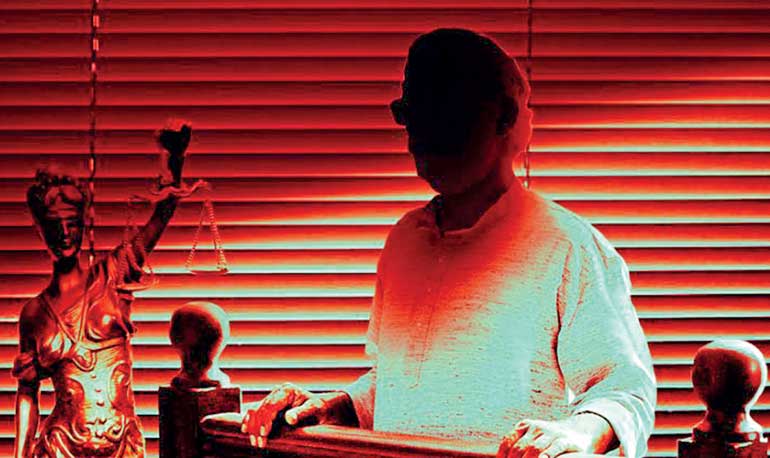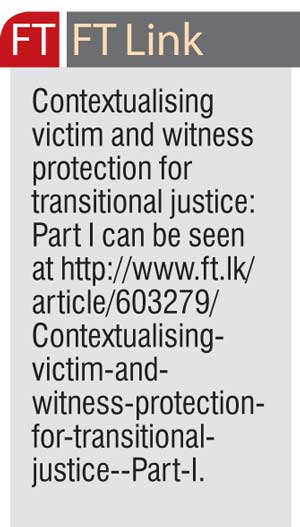Saturday Apr 26, 2025
Saturday Apr 26, 2025
Thursday, 16 March 2017 00:00 - - {{hitsCtrl.values.hits}}
 The design of a transitional justice based victim and witness protection program should be informed by the unique challenges of victim and witness protection in Sri Lanka
The design of a transitional justice based victim and witness protection program should be informed by the unique challenges of victim and witness protection in Sri Lanka
By Medhaka Fernando, South Asian Centre for Legal Studies
The previous article in this serial titled Contextualising Victim and Witness Protection for Transitional Justice discussed three key considerations which victim and witness protection schemes within transitional justice must grapple with.
The first of these was the necessity for victim and witness protection (VWP) schemes within transitional justice to consider their protection and assistance activities as obligations due towards victims and witnesses, in accordance with present day international standards. Second, witness assistance measures such as psychosocial support and counselling- which are traditionally regarded as being subsidiary activities within witness protection- ought to be prioritised on an equal scale with witness protection in a transitional justice context. Third, transitional justice mechanisms must carefully consider the suitability of protection arrangements that rely heavily on State institutions or actors given their potential involvement in violence and other atrocities.
Owing to the above considerations and the inherent weaknesses within Sri Lanka’s national witness protection Act, the article advocated for specialised, independent and self-sufficient VWP units to be established within each of Sri Lanka’s proposed transitional justice mechanisms. The present article will explore possible operational models that could be adopted by the VWP units within each of Sri Lanka’s existing and proposed transitional justice mechanisms.
Operational models
National witness protection programs, international courts and ad-hoc transitional justice mechanisms have followed varying operational models for the provision of VWP. These operational models have taken diverse approaches in relation to,
a.the internal arrangements in place for threat assessment and
b.the internal arrangements in place for VWP and assistance,
c.the level of cooperation between the protection unit and external entities for threat assessment and VWP
Internal arrangements for threat assessment
The United Nations Office on Drugs and Crimes defines a threat assessment as an operational technique which is utilised to identify, assess and manage threats of violence towards victims and witnesses. The VWP units within Sri Lanka’s transitional justice mechanisms would first have to decide whether they would be carrying out threat assessments independently, by themselves or whether they would seek and rely on information and assistance from the other sections of the mechanism.
In the majority of national protection programs, threat assessments are carried out by the witness protection unit alone. This has the advantage of guaranteeing the impartiality and independence of the threat assessment process. In contrast, victim and witness protection units within international courts and ad-hoc transitional justice mechanisms have sometimes opted to utilise cooperative models for their threat assessment activities.
For example, in the International Criminal Court (ICC), initial threat assessments may be carried out by investigators who assess the risks involved in making contact with a potential witness. This initial assessment is generally carried out in consultation with local/international partners. Subsequently, the VWU carries out its own threat assessment to determine whether an individual would be eligible to be a part of the ICC’s official protection program. This assessment is carried independently, without relying on prosecution or defence information. It relies instead on local sources and intelligence. This guarantees the neutrality of the assessment process.
The ability of the prosecutor to carry out its own threat assessment allows the court to respond immediately to vulnerable witnesses, safeguard them and gain their confidence. It also ensures that the VWU is not overburdened with cases that do not involve serious risks. This enables the VWU to focus its resources on preventing most likely and serious threats. For these reasons, Sri Lanka’s transitional justice mechanisms may also consider a similar arrangement whereby the unit making the first contact with witnesses—an outreach or an investigative unit for example—is empowered to carry out a preliminary threat assessment.
Internal arrangements for victim and witness protection and assistance
Beyond threat assessments, the carrying out of protection activities also requires cooperation between VWP units and other units or organs of a given transitional justice body. For instance, the sharing of information between the VWP unit and an investigating unit or a prosecutor’s office could inform decision-making with respect to specific protection measures. This would ensure that these measures are adapted to evolving situations on the ground and to developments in a given investigation or judicial process. Accordingly, the VWUs of international and hybrid courts such as the ICC and the Special Court for Sierra Leone are required to provide protection and support to victims and witnesses in consultation with other key internal organs of the court such as the Chambers, Prosecutor’s Office and Defence.
In addition, internal cooperation also facilitates the continuous protection of witnesses throughout their engagement with the mechanism’s various units at different stages of the procedure. For instance, the ICC VWU may recommend protective measures to be implemented by other organs/personnel of the court, when dealing with victims and witnesses. Thus, the ICC’s VWU compiled a code of conduct for the ICC’s investigative personnel to enhance the safety of victims and witnesses throughout the investigation. This collaborative model would be useful for various transitional justice mechanisms in Sri Lanka. For instance, the Victim and Witness Protection Division of the OMP could compile best practices and issue directions to the Office’s Tracing Unit to guide its interactions with witnesses. Similarly, in the event an Outreach Unit is established within the OMP, the VWP Division could devise security protocols for the reception of complaints whether orally, through telephone or other platforms.
Finally, a collaborative approach may empower units other than the VWP unit to implement measures that fall short of an admission into a strict witness protection program. For instance in the ICC, the prosecutor’s office can take measures falling short of identity change and relocation to protect witnesses involved in prosecutions. Similarly, the SCSL’s prosecutor may take all necessary measures to provide for the safety, support and assistance of potential witnesses and sources. This affords prosecutors sufficient flexibility to ensure the safety of witnesses unless or until the VWU takes over the protection responsibilities. However, this model also presents downsides as there may be confusion and conflicts between the protection activities undertaken by the VWP unit and that carried out by other units. Thus, Sri Lanka’s transitional justice mechanisms should carefully delineate the respective protection competencies of the formal protection unit and those of other units, if they decide to opt for a cooperative model of this nature.
Cooperation between the protection unit and external entities
The successful operationalisation of a victim and witness protection scheme would often require cooperation with entities external to the mechanism within which the protection unit is placed. These generally include prosecutorial/law enforcement officials of a given country, local level intermediaries and non-governmental organisations who have, in the past, given witness protection in an unofficial capacity.
Threat assessment often involves the participation of—and information from—law enforcement entities external to the protection unit. For instance, in the national protection programs of Australia, South Africa and the USA, threat assessments are carried out by law enforcement bodies. This is because these bodies often have the most relevant and up to date information. Similarly, ad-hoc transitional justice mechanisms may also rely on external entities for threat assessment. For instance, the SCSL also resorted to security and intelligence agents of Sierra Leone for its threat assessments. However, as pointed out in the first article in this series, threats to victims and witnesses in Sri Lanka are most likely to emerge from State level entities. Therefore, it would be unwise for witness protection units of Sri Lanka’s transitional justice mechanisms to rely on security and intelligence agents for threat assessments.
The carrying out of protection measures may also involve law enforcement bodies which have the capacity to wield the coercive power of the State. However, for the same reasons explained above, in Sri Lanka, the involvement of law enforcement bodies is undesirable. A possible alternative could be for transitional justice mechanisms to carefully vet and recruit law enforcement personnel to be seconded to the mechanisms.
Another option for external cooperation is to outsource witness assistance, support and protection to local level intermediaries. This was a practice followed by the ICC. In Sri Lanka, transitional justice mechanisms could rely on private security firms or local protection/vigilance structures to discharge assistance and support functions. However, the outsourcing of protection functions to external entities of this nature must be contingent on a stringent evaluation. To this end, the mechanisms must thoroughly review the role that these entities have played politically, socially or militarily in the past and their susceptibility to political influence.
Finally, transitional justice mechanisms may also rely on inter-governmental and non-governmental organisations for witness protection and assistance measures. Civil society organisations have at times provided safe houses and shelters for vulnerable victims and witnesses. Transitional justice mechanisms may therefore utilise these resources and expertise to carry out their protection activities. A similar approach was adopted by other transitional justice mechanisms. For instance, the ICC has relied on the support of the UN Mission in the DRC (MONUC) for witness protection. Such a model could lessen the financial burden on transitional justice mechanisms. It also enables the continuation of witness protection after the transitional justice mechanism is disbanded upon the completion of its mandate.
Conclusion
The design of a transitional justice based victim and witness protection program should be informed by the unique challenges of victim and witness protection in Sri Lanka. Therefore, whenever it is necessary to involve law enforcement officers in witness management or protection programs, safeguards must be in place to guarantee their independence from the authority of the police, their professionalism and impeccable human rights record. Any model for witness protection should also capitalise on existing systems for victim management and protection. Thus, transitional justice mechanisms must consider involving civil society actors in the design and carrying out of witness management measures that fall short of admission into a full-fledged protection programme. Other forms of cooperation for threat assessments and protection activities are also essential to overcome the challenges of witness protection in a transitional justice framework. For instance, internal cooperation between the different units/divisions of the proposed OMP or Truth Commission or Special Court could facilitate an immediate response to the needs of vulnerable victims and witnesses. It would also enable the adoption of protection measures to suit the evolving challenges at the ground level.
Discover Kapruka, the leading online shopping platform in Sri Lanka, where you can conveniently send Gifts and Flowers to your loved ones for any event including Valentine ’s Day. Explore a wide range of popular Shopping Categories on Kapruka, including Toys, Groceries, Electronics, Birthday Cakes, Fruits, Chocolates, Flower Bouquets, Clothing, Watches, Lingerie, Gift Sets and Jewellery. Also if you’re interested in selling with Kapruka, Partner Central by Kapruka is the best solution to start with. Moreover, through Kapruka Global Shop, you can also enjoy the convenience of purchasing products from renowned platforms like Amazon and eBay and have them delivered to Sri Lanka.
Discover Kapruka, the leading online shopping platform in Sri Lanka, where you can conveniently send Gifts and Flowers to your loved ones for any event including Valentine ’s Day. Explore a wide range of popular Shopping Categories on Kapruka, including Toys, Groceries, Electronics, Birthday Cakes, Fruits, Chocolates, Flower Bouquets, Clothing, Watches, Lingerie, Gift Sets and Jewellery. Also if you’re interested in selling with Kapruka, Partner Central by Kapruka is the best solution to start with. Moreover, through Kapruka Global Shop, you can also enjoy the convenience of purchasing products from renowned platforms like Amazon and eBay and have them delivered to Sri Lanka.